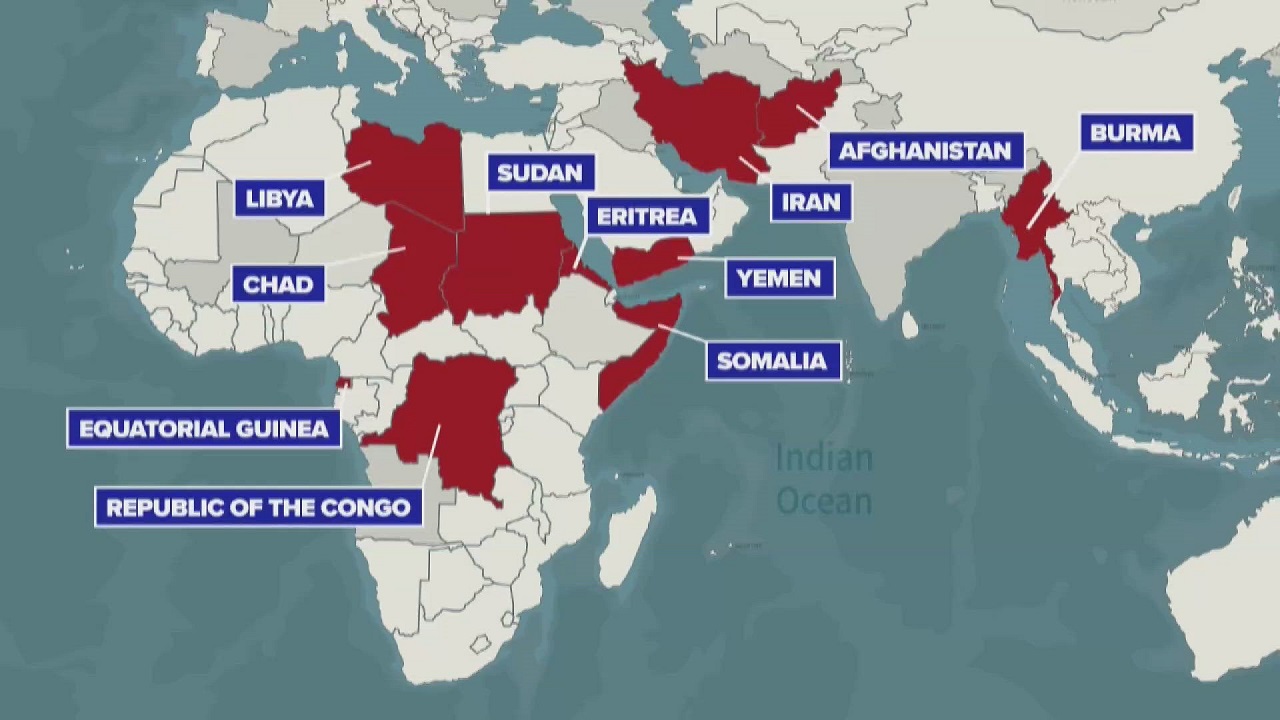Travel Ban Reinstated: National Security and Immigration Politics
Context:
Nearly five months into his second term, U.S. President Donald Trump has signed a new travel ban, reviving elements of his earlier immigration policy. The ban, aimed at curbing immigration surges, will take effect from 12:01 a.m. on June 9.
What is a Travel Ban?
-
A travel ban is a federal policy that restricts or prohibits nationals from specific countries from entering the United States.
-
It may involve complete bans or partial restrictions on visa categories.
Key Features of the New Travel Ban
-
Total ban on entry from 12 countries.
-
Limited visa restrictions imposed on 7 additional countries.
-
Intended to revive Trump's earlier immigration agenda.
Purpose of the Ban
-
To prevent immigration from countries with:
-
Poor screening and vetting systems
-
High visa overstay rates
-
Links to terrorism
-
Refusal to repatriate deported nationals
-
-
The ban also aims to pressure countries into cooperating with U.S. security protocols.
Trigger for the New Ban
-
The decision follows a deadly attack in Boulder, Colorado, allegedly committed by an Egyptian national.
-
Although Egypt is not on the list, the incident was used to highlight the risks of visa overstays and weak screening procedures.
Countries Mentioned with Specific Allegations
-
Iran and Cuba: Accused of being state sponsors of terrorism
-
Somalia: Described as a terrorist safe haven
-
Afghanistan: Claimed to be under the control of the Taliban
-
Haiti: Accused of sending hundreds of thousands of undocumented migrants
Controversies and Claims
-
Trump and Vice President JD Vance made controversial and unverified claims, such as immigrants abducting pets.
Exemptions from the Ban
The travel ban does not apply to:
-
Current visa holders
-
U.S. permanent residents
-
Dual nationals traveling on a non-restricted passport
Historical Background of Trump's Travel Bans
-
2016: Trump’s campaign included calls for a “Muslim ban”, using inflammatory rhetoric.
-
January 2017 (First Ban): A 90-day ban on 7 Muslim-majority countries. Struck down by a federal court.
-
March 2017 (Second Ban): Revised to exclude visa and green card holders. Also blocked by courts.
-
September 2017 (Third Ban): Expanded to include North Korea and Venezuela. Upheld by the Supreme Court in June 2018.
-
January 2020 (Fourth Ban): Targeted immigrants, not tourists, from several African and Asian countries.
-
2021: President Joe Biden repealed all previous bans, calling them a “stain on our national conscience.”
Differences in the Current Ban
-
Avoids explicitly naming Muslim-majority countries.
-
Cites national security, terrorism, and lack of cooperation as justifications.
-
Seen as more legally cautious—delayed announcement suggests careful internal deliberation.
-
Legal experts believe it may withstand judicial scrutiny if fairly and consistently enforced.
Broader Anti-Immigration Push
The travel ban is part of Trump’s wider second-term immigration crackdown, which includes:
-
Declaring a national emergency at the southern border
-
Denying asylum claims
-
Conducting ICE raids
-
Restricting student admissions
Conclusion
President Trump’s new travel ban represents a strategic continuation of his hardline immigration policies, framed this time under national security and legal defensibility. While its enforcement and legal standing remain to be tested, the policy reflects a renewed push for stringent border and visa controls, with broader geopolitical and domestic implications.



.jpg)
Comments (0)